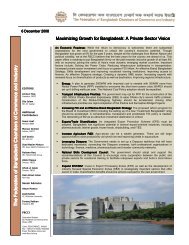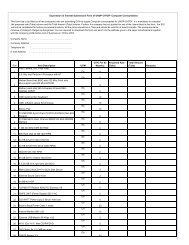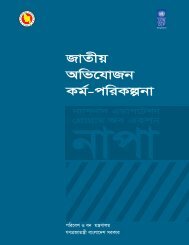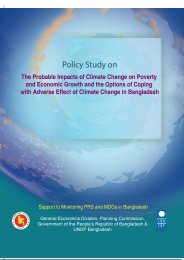Framework for a Strategy of UP Revenue/Resource Mobilisation ...
Framework for a Strategy of UP Revenue/Resource Mobilisation ...
Framework for a Strategy of UP Revenue/Resource Mobilisation ...
Create successful ePaper yourself
Turn your PDF publications into a flip-book with our unique Google optimized e-Paper software.
<strong>of</strong>ficial <strong>for</strong>mula. 6 However, in many cases this assessment are quite abbsent. In many cases,<br />
arbitrary adjustments are made, whether on the basis <strong>of</strong> assumptions <strong>of</strong> household income or <strong>for</strong><br />
other reasons, so that the final assessments bear little relationship to the <strong>for</strong>mula. In other places,<br />
<strong>UP</strong>s are making much simpler assessments based on the number <strong>of</strong> rooms, type <strong>of</strong> construction and<br />
facilities (water supply, sewerage etc.). These assessments may be sufficiently fair, especially, if<br />
they are made in a transparent way. However, the problem with either arrangement is that<br />
assessments are <strong>of</strong>ten not made systematically and adjustments <strong>for</strong> household income or poverty<br />
may not be made transparently. As a result, there may be significant inequities in the assessment<br />
system. This can undermine people’s trust in the system, and there<strong>for</strong>e their willingness to pay.<br />
The calculation set out in the Ministry’s 2003 guideline (but which is based on established practice<br />
and applies also in paurshavas and cities) contains a number <strong>of</strong> anomalies. Firstly, it gives a<br />
reduction on the assessment <strong>for</strong> the interest costs where a property is subject to a loan or mortgage.<br />
This is not appropriate, since it creates an inequity simply according to the method <strong>of</strong> financing. It<br />
is also likely to benefit the better <strong>of</strong>f who are more likely than the poor to use loan finance <strong>for</strong> their<br />
house. Secondly, it gives a 25% reduction <strong>for</strong> owner occupiers, on the grounds that they are not<br />
earning income from the house. However, in principle, the type <strong>of</strong> tenure is irrelevant to the value<br />
<strong>of</strong> the property, or to the costs to the local government <strong>of</strong> providing services to that property. This<br />
creates an inequity between types <strong>of</strong> tenure, benefiting owner-occupiers. 7 If the holding tax is to<br />
remain the main source <strong>of</strong> <strong>UP</strong> revenue, it is suggested that these anomalies be removed.<br />
In practice, few <strong>UP</strong>s appear to be using this method <strong>of</strong> assessment, whether <strong>for</strong> lack <strong>of</strong><br />
understanding <strong>of</strong> the rental value method or lack <strong>of</strong> data, or simply because it seems unnecessarily<br />
complicated. Even where <strong>UP</strong>s attempt to use the method, the final assessment is usually adjusted<br />
(<strong>of</strong>ten without any clear relationship to the original figure) on the grounds that the household cannot<br />
af<strong>for</strong>d to pay, or <strong>for</strong> some other reason. The resulting, adjusted assessments are generally much<br />
lower than the <strong>for</strong>mula would have suggested, especially <strong>for</strong> the more valuable properties. There<br />
are, there<strong>for</strong>e, some doubts about the validity <strong>of</strong> the assessment, even when the <strong>of</strong>ficial method is<br />
applied.<br />
6 An NGO, Comilla Shastha Sheba Foundation, has started <strong>of</strong>fering a service to <strong>UP</strong>s in one district (perhaps more) to<br />
make assessments <strong>of</strong> holding tax. They <strong>of</strong>fer to compile the <strong>UP</strong>’s assessment register using the proper ARV method,<br />
at no cost to the <strong>UP</strong>. They generate some revenue by <strong>of</strong>fering to households a plot number plate, but this is optional.<br />
From the one example seen, it appears that the assessment register is properly compiled, although how accurate or<br />
uni<strong>for</strong>m are the valuations is difficult to tell. Such a service could well be appropriate <strong>for</strong> <strong>UP</strong>s to use, although it is at<br />
present only available in a limited area<br />
7 Nor can it be assumed that the resulting higher tax <strong>for</strong> rented housing is born by the landlords: as with any tax, the<br />
burden is shared between buyer and seller according to the elasticity’s <strong>of</strong> supply and demand; thus at least part <strong>of</strong><br />
the burden <strong>of</strong> the high tax – and probably the majority in the case <strong>of</strong> rented housing – will be borne by the tenant.<br />
8










